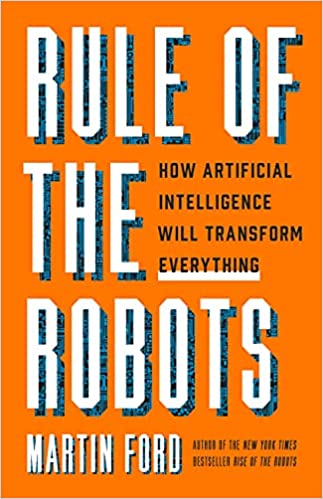You have /5 articles left.
Sign up for a free account or log in.
 Rule of the Robots: How Artificial Intelligence Will Transform Everything by Martin Ford
Rule of the Robots: How Artificial Intelligence Will Transform Everything by Martin Ford
Published in September 2021
It is hard to overstate the academic mind share that Martin Ford captured in his 2015 book, Rise of the Robots.
From 2015 until the start of 2020, a theme of almost every higher ed tech and learning conference that I attended was the existential imperative for universities to prepare our students for the coming jobless future.
In the race between robots and humans, the inevitable result seemed to be robots winning out.
Ford’s 2015 book provided much of the intellectual foundations for this concern. In that deeply researched and well-argued book, Ford explained how intelligent machines would soon replace much of the work done by people.
Now Ford has a follow-up book to Rise called Rule of the Robots. In this book, Ford updates his arguments to put artificial intelligence (AI) at the center of the story.
AI, in Ford’s estimate, is on the cusp of becoming a general-purpose technology. The impact of AI will be as profound as that of electricity, as artificial intelligence will fundamentally change how every other technology gets produced and utilized.
Just as the preceding century could be defined as the age of electricity, the century to come will be remembered as the age of AI.
Rule of the Robots is a sober, even at times cautious, look into our technological future. Unlike in his first book, Ford seems to be a bit more cautious in offering his predictions about the likely impact of AI as infrastructure.
Readers will come away with a good understanding of the technological fundamentals of AI and the debates concerning the likely impact of a maturing set of narrow AI technologies.
My big complaint is that Ford grapples too little with his central thesis that robots represent an existential threat to paid human employment.
If robots are bound to take all the jobs, then that future sure is taking its time arriving.
The reality that our society faces today is not too few jobs, but too many.
In the region that I live in, the schools can’t find enough teachers or bus drivers. The hospitals can’t find enough nurses. The restaurants can’t find enough servers. The construction companies can’t find enough skilled labor. The supermarkets can’t find enough cashiers. The childcare centers can’t find enough childcare workers. Trucking companies can’t deliver goods because there are not enough truck drivers. And so on, and on, and on.
Today’s robots are nowhere near capable enough to replace today’s workers. Even if all the AI technologies that Ford describes end up maturing in the next few years, the result will not be robots capable of the varied types of work at which humans excel.
We may need robot nurses and childcare workers, but we will never get them.
The argument for a universal basic income (UBI) that Ford discusses in Rule of the Robots is that the future will be one of technology-induced employment. A universal wage will be necessary as robots will take all available paid work.
The reality may be that a UBI is necessary to enable more humans to engage in paid work. To the extent that a UBI supports workers being able to find housing and childcare, a universal basic income may enable people to move to where the jobs are and go to work rather than staying home to take care of their kids.
There is a good conversation to be had about the role that AI will play in higher ed. Rule of the Robots should help us look beyond COVID to reignite that conversation.
Once that AI-centric campus discussion restarts, I hope that we can begin puzzling out together the reasons behind our acute shortages of nurses, teachers, childcare providers, food servers, plumbers, carpenters, electricians, truck drivers and every other type of worker that we have now only realized to be genuinely essential.
From what I can see, smart robots can’t get here fast enough.
What are you reading?




